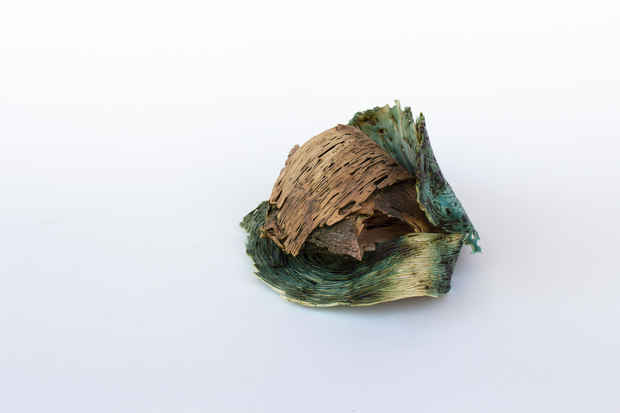“Archipelago” Exhibition
The Chimney

[Image: Mariana Garibay Raeke "Ellipsis" Porcelain clay, copper carbonate, chrome oxide, sulfure, gypsum, wood, (2017)]
This event has ended.
The Chimney presents Archipelago, a group exhibition with works by Ernesto Burgos, Robin Cameron, Kiran Chandra, David de Tscharner, Andrew Erdos, Mariana Garibay Raeke and Jess Willa Wheaton. Archipelago explores fragmented territories where fantasies, precarious balance and parallel realities seem to coalesce inside The Chimney. The artists’ works are considered as islands of thoughts, practices and forms where discarded and everyday materials have been re-used to emanate new exotic realms. Oscillating between collapse and renewal, biomorphic figures and absolute abstraction, the works create a sensual visual dialogue that defy singular point of references and endorse diverse truths.
Ernesto Burgos’ Hiraeth’s organic shape rises and invades viewers’ territory. Made of cardboard, fiberglass, charcoal and paint, his sculpture seems to contort into amorphous forms and reveals on its surface, the expressiveness and controlled randomness of the spray paint. Asymmetric, undeterminable, seemingly instable, his sculpture seems to elude the laws of proportion. The directions in which the forms grow appear boundless and unrestricted, offering our gaze an interrupted rhythm.
Robin Cameron’s sculptures are poetic assemblages that allude to anthropomorphic shapes. By selecting broken shards of found and discarded ceramics, deemed as failures and re-firing the shards with new porcelain to give the works a second life. While the works may suggest functionality through the medium of ceramics and their resemblance to the body or objects such as vases, the vulnerability of these joined ceramic fragments celebrate the idea of productive failure.
Movement of forms and indefinite state are manifested in David de Tscharner’s suspended installation Frost. Those mobiles are the accidental result of paint inserted in resin and Plexiglas and constitute a tridimensional puzzle. Resembling a chaotic system, this assemblage relies on a fragile equilibrium that demands to be altered and re-arranged by the public into new volumes and shapes.
Kiran Chandra’s interest in language systems is shown in a vitrine installation containing abstract watercolor and gouache paintings, paired with hand made and natural objects - stones, dried bark, driftwood, shells, and seed husks. Through the placement of objects - natural and artificial - with images she makes a space for new linkages, connections and rhythms in the visual repetitions that develop between and amongst them- presenting as a phenomenological and subjective lexicon.
Andrew Erdos’ most recent series of works consist of abstract dystopian landscapes created by uncontrolled chemical reactions between glass, silver and intense heat. Similar to tectonic plates colliding, the fused glass panels create a map of reckless geometry, islands of color and texture. In continuity with his exploration of time, Erdos further delves into Man’s quest to become “master and possessor” of nature.
Mariana Garibay Raeke’s ceramic and paper pieces explore folding as a way of transforming flatness into three-dimensional objects. In one instance, angular lines become a flexible matrix where paper and concrete harden into geometric husks. In the other, line drawings of liquid clay are lifted and folded into rounded bodies colored by chemical reactions induced by heat. Each process and the resulting objects are specific to the unique characteristics of the materials. Placed over a plinth of gypsum , the ceramic pieces are arranged in conversations with natural elements such as rocks, which refer to the origin and source of the clay, as well as to the chemical elements that produce their coloring.
Jess Willa Wheaton’s collages address the plethora and mutability of images available today, through a tactile process of cutting, combining, adding and subtracting. Her two works are each mounted on an individual wall that is proportional to the work and reflective of its color, serving as an expanded frame. Architecturally, these walls/frames also function as positive manifestation of the negative space of the niches present in The Chimney’s industrial brickwork. Working with found printed images from diverse sources, in each collage Wheaton creates a spatial construction that exists between preternatural landscape and almost tactile abstraction; melding to transcend the images’ original history and divulge a new and nuanced visual melody.
Media
Schedule
from June 09, 2017 to July 09, 2017
Opening Reception on 2017-06-09 from 18:30 to 21:30